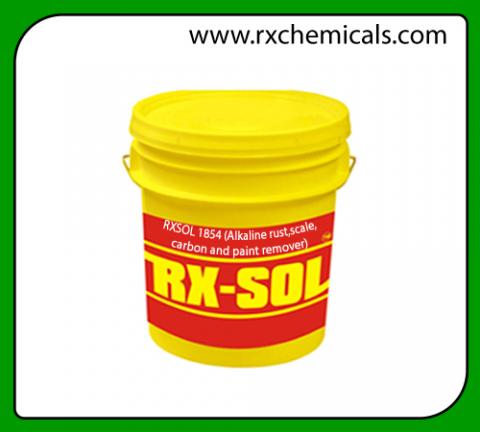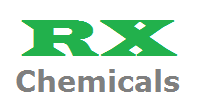
RXSOL 1854 Alkaline Rust Scale Carbon and Paint Remover
RXSOL 1854 is a strongly alkaline liquid concentrate containing sequestrants, surfactants and other additives in aqueous solution.
RXSOL 1854 is a strongly alkaline liquid concentrate containing sequestrants, surfactants and other additives in aqueous solution. RXSOL 1854 is a general purpose cleaner. It will remove oil, grease, rust, carbon and many types of paint. Rust is removed without attack on the base steel and there is markedly less tendency for re-rusting to occur compared with acid pickling.
RXSOL 1854 has verstile used in Industries. It is Heavy duty Alkaline ,Degreasing Decarbonising, rust removal & Paint stripping compound used for Proceco washing machine.
Testing chemicals required
Indicator solution No.13 (Thymolphthalein)
Testing solution No.9 (0.1N sulphuric acid solution)
Method of use
RXSOL 1854 is used at a concentration of 25 to 50% v/v in water. The exact concentration will be determined by the particular use. The operating temperature should be kept at 82°C to 88°C. Immersion periods will vary with the type and degree of contamination. Light rust will be removed in about 15 minutes whilst heavy carbonaceous deposits may require an hour.
If the main use of this product is de-rusting and heavy contamination with oil and grease are also present it is desirable to remove the latter first in order to prolong the life of the RXSOL 1854.
Method of control
Restore the volume of the tank to its original level, if necessary, by adding water. Thoroughly mix and take a sample of 100-200ml. After allowing to cool to ambient, add active carbon, stir and allow to stand for 30 minutes. Filter solution through a Whatman No1 paper until about 100ml is obtained. Pipette 25ml into a 250ml volumetric flask. Make up to the mark with distilled water. Pipette 10ml of this solution into an Erlenmeyer flask and add 5-10 drops of Indicator No.13. Titrate against Testing solution No.9 until the blue colour is discharged leaving a pale yellow-green solution. Record the volume used as (V)ml.
The bath strength is calculated as follows:
Measured strength (%v/v RXSOL1854) = V x 1.18
Record this as (MS).
If the bath is below the required strength, add further RXSOL 1854 according to the following:
Volume RXSOL 1854 required = (CR – MS) ÷ (1 – (CR x 0.01)) x (TV ÷ 100)
Where CR = concentration required (%v/v).
TV = volume RXSOL 1854 solution in tank
MS = measured strength.
Effects on materials :
RXSOL 1854 is safe to use on all Ferrous Alloys but it will rapidly attack aluminium, zinc and tin. There is a negligible effect on magnesium, cadmium, nickel, cobalt, titanium and their alloys. Slight attack on copper may occur. Glass and ceramics will be etched by RXSOL 1854. Polythene, PVC and PTFE are substantially unaffected but degradation of some plastics and rubbers is possible.
Appearance: Dark brown liquid.
Density: 1.33 g/ml @ 200C.
Flash Point: Non-flammable.
These are typical values only and do not constitute a specification.
#RXSOL1854AlkalineRustScaleCarbonPaintRemover
#AlkalinePaintRemover
#AlkalineRustCarbonCleaner
Alkaline Rust Scale Paint Remover manufacturer and supplier in Fujairah, Sharjah, Dubai, Abudhabi, Ajman, UAE, Barka, Ruwi, Muscat, Oman, Mumbai, Kandla Gandhidham, Sikka Jamnagar, Chennai, Ennore, Kolkata, Haldia, Paradip, Muscat Barka Oman
Equipment materials
Mild steel is suitable for tank construction but it should be at least 6 mm (¼”) thick, welded inside and out. Heaters must be stainless steel or Inconel.
Safety guidance
Before operating the process described it is important that this complete document, together with any relevant Safety Data sheets, be read and understood.
General information
RX Marine International supplies a wide range of chemical products and associated equipment for cleaning, sanitising, descaling, paint and carbon removal, metal protection and non-destructive testing. Sales Executives are available to advise on specific problems and applications.
Labour and environmental protection
All local and national regulations on the transport, storage, use and waste treatment of chemicals in concentrated or diluted form and as working solutions must be obeyed. Further specific information on the products can be found in the EC Safety Data Sheets supplied. The user should also pay strict attention to information and hazard symbols shown on product labels.
Waste disposal
All waste waters must be treated in accordance with national legislation and local regulations prior to discharge to the sewer.




